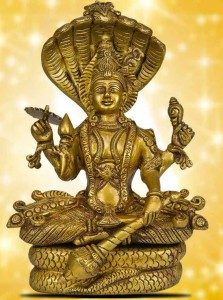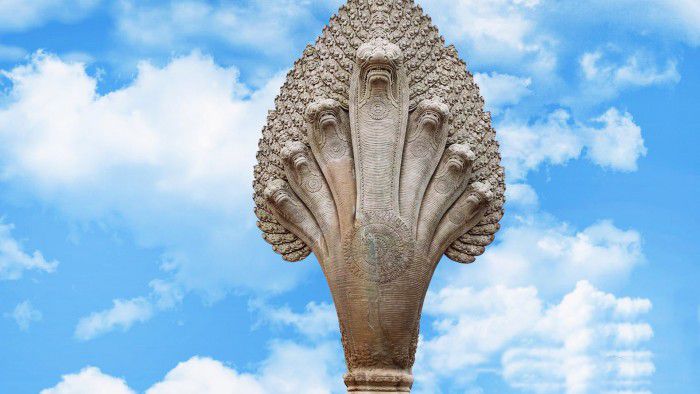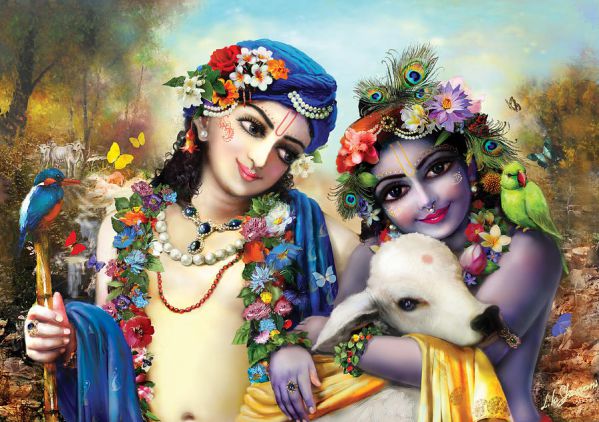No products in the cart.
Sheshnag (the serpent god) comprises an important part of Hindu mythology. As the reclining couch and the roofing canopy of the god Vishnu, it has been a god venerated by all and worshipped by many for centuries.
It is considered to be the king of the serpent race and the ruler of the infernal regions called PATAL. God Vishnu sleeps over the bed of its coils during intervals of creation. SheshNag is also represented as one supporting the world on its hood. The Nags have three Kings, VAASUKI, TAKSHAK and SHESH. Shesh is said to represent the ‘remainder’ when the universe is destroyed and the power of creation (Lord Vishnu) rests on its coils.
The Nags are dwelling in an underworld, called NAG LOKA, which is an immense domain crowded with palaces, houses, towers and pleasure gardens. According to Varaha Purana, three of the lower worlds, PATAL, ATAL and SUTAL belong to the Nags. Their favorite places of visitations are the banks of river, IKSHUMATI, the NAIMISH forest on the shores of the GOMATI, the northern banks of the GANGA and the NISHAD land. They also dwell under the sea. These nags are not always the enemy of man and they even inter marry with them. Arjun of Mahabharata married a Nag girl named Uloopi.
Sheshnag as Ananta, the Timeless
Shesh Nag is the serpent with a thousand heads and is also called ‘ANANTA ‘, the timeless, because it does not die with destruction of the universe. All serpents are of divine extraction, because they are the children of Kadru, who herself is the descendant of Kashyap. The main city of Nags is Bhogvati (the city of pleasures), where Shesh appears like the White Mountain adorned with gems. The later Purana identify Shesh even with Krishna as Vishnu. Shesh is said to be the soul of Krishna’s brother Balrama. Thus Shesh emerged from the body of dying Balrama and entered the earth, where he received a warm welcome by all other serpents.
Sheshnag’s Avatar as Lakshman
In the Treta Yuga, Vishnu decided to descend on earth as Lord Rama, the seventh avatar of Lord Vishnu ( Also Read: Dashavatar – the 10 Avatars of Lord Vishnu). Sheshnag accompanied him and took avatar as Lakshman–the younger brother. They were virtually inseparable. Lakshman was the younger brother and therefore had to obey every command his elder brother, Lord Rama, gave. Lakshman carried out the task beautifully and is commended for his staunch devotion to Lord Rama.
 In his avatar as Lakshman, Sheshnag rendered unflinching service to God and received profuse grace. He exemplified the attitude of an ideal brother and self-sacrifice. When Lakshman was lying unconscious after being hit by the Brahmastra in the battlefield, Lord Rama said that he could get anything in this world but not a brother like Lakshman. Such was the love and devotion between the two.
In his avatar as Lakshman, Sheshnag rendered unflinching service to God and received profuse grace. He exemplified the attitude of an ideal brother and self-sacrifice. When Lakshman was lying unconscious after being hit by the Brahmastra in the battlefield, Lord Rama said that he could get anything in this world but not a brother like Lakshman. Such was the love and devotion between the two.
Lakshman abandons life because Sage Durvasa appears at Rama’s doorstep and seeing Lakshman guarding the door, demands an audience with Rama. At the time, Rama was having a private conversation with Yama. Before the conversation began, Yama gave Rama strict instructions that their dialogue was to remain confidential, and anyone who entered the room was to be relieved of their life. Rama agreed and entrusted Lakshman with the duty of guarding his door. When Durvasa made his demand, Lakshman politely refused. The sage grew angry and threatened to curse all of Ayodhya if Lakshman did not immediately inform Rama of his arrival. Lakshman, in a dilemma, decided it would be better that he alone die to save all of Ayodhya from falling under Durvasa’s curse and so interrupted Rama’s meeting to inform him of the sage’s arrival. Rama quickly concluded his meeting with Yama and received the sage with due courtesy. Lord Rama was Maryada Purushottam and stood by his words. In order to fulfill his brother’s promise, Lakshman went to the banks of the river Sarayu resolved on giving up the world through penance. And reaches Vaikunthah before Lord Vishnu waiting for him.
Sheshnag’s Avatar as Balarama
Balrama was the son of Vasudeva and Devaki. He was the elder brother of Lord Krishna. He is said to be the incarnation of “Sheshnag” (Serpent God on whom Lord Vishnu rests). His weapon was a plough. He is also called ‘Haldhar’. He is a protector from desires, the divinity of strength or the strength of the divine, symbolizing duty, honesty and simplicity.
In the Treta age (there are four ages according to Hinduism- Krita (Sat) Yuga, Treta Yuga, Dwapar Yuga and Kaliyuga) Balarama’s eternal incarnation was as Lakshman.
When Devaki was pregnant with the seventh child, Lord Vishnu called upon Yogmaya (divine illusion) and said, “Devaki’s seventh eternal embryo should be installed in Rohini’s (another wife of Vasudeva) body.” Yogmaya transferred the embryo to Rohini’s womb from Devaki’s womb. This was done to prevent Kans from killing him at his birth. Kans was destined to be killed by Devaki’s eighth son, and not to take any chances he was killing all the sons born to Devaki at birth.
Rohini got pregnant and after nine months, eternal incarnation in the form of Balrama was born. Kans was informed that Devaki’s seventh child was dead. Balrama was growing up at Nandbaba’s house. After one year Krishna was born. Both of them were beautiful and attractive. Sage Garg had said at the time of naming ceremony that this child will have infinite strength (BAL). That is why he is called Balrama. Because he was drawn from Devaki’s to Rohini’s womb, He became known as Lord Sankarsana (ploughing) and because of His strength, He is known as Lord Balrama. He was so powerful that he, single handedly, at a very tender age, killed the great demon, Asura Dhenuka, who was in the form of an ass.
Just before Rukmani’s marriage, Revati, daughter of King Raivat of Aanart region was married to Balrama. For lifetime, Balramaji was always with Krishna and protected him. He was elder to Krishna so he could not order him but whenever Krishna needed him; he never hesitated to give his service to him.
He had contributed towards killing the demons and giants. Balrama had gone with Krishna in the Dhanush Yagna organized by Kans. He supported Krishna in killing Kubal, the elephant. While wrestling, Balrama threw Mushtik (trusted lieutenant of Kans) so badly that he was killed on the spot.
Jarasandh used to attack Mathura on and off. Balrama, along with the army of the Yadavas used to fight with Jarasandh and send him back every time. When Kalyavan came to attack, even Jarasandh came with him. Balrama caught hold of Jarasandh with his strong hands. Krishna asked Balrama to leave him saying that there were many demons and if Jarasandh is left alive then he will make an army of the demons. When Jarasandh will come once more with the demon’s army, many more demons can be killed. So Balrama relieved him. Jarasandh had twenty-three armies with weapons. Slowly and gradually, Balrama defeated them all. When Kalyavan had encircled them – then Krishna ran in front of them and Balrama confronted his army. Krishna got Kalyavan burnt and Balrama defeated his army.
Balrama trained both Bhīma and Duryodhana in club-fighting. Eventually, his students faced one another in the final combat of the Kurukshetra war. Because of this, Balrama chose to remain neutral during the conflict. Eventually when Bhīma (of greater strength) defeated Duryodhana (of greater skill) by dealing a blow below the navel with his mace (a move against the rules of mace combat), Balrama threatened to kill Bhīma. This was only prevented when Krishna reminded Balrama of Bhīma’s vow to kill Duryodhana by crushing the very thigh he exposed to his wife Draupadi.
Today also there are many temples of ‘Dauji’ (elder brother) where he is worshipped. It is a common belief, he bestows materialistic richness.
Lord Balrama is also known as “God of farmers”. Farmers in India worship him before any task. His weapon plough is worshipped by farmers before all important tasks related to farming. The funeral ceremony of Abhimanyu, the son of Arjun, was performed by Balrama, as He was the maternal uncle.
Due to a curse placed on the Yadus dynasty they were to be the cause of their own destruction. This took place thirty-six years after the end of the battle of Kurukshetra. Balrama took part in the drunken battle that caused the destruction of the rest of the Yadus, and after he witnessed the disappearance of Lord Krishna, Lord Balrama sat down in a meditative state. In his last stages, a great white snake emerged from his mouth and he departed from this world. The place where he departed from this world is situated about 1 km far from Somnath temple in Gujarat. As the local people of Vera Val (a town in Gujarat) say, there is one cave in the town where it is believed the white snake came out of Balarama’s mouth.








Please stop mentioned hindu epics as mythology. When a hindu himself does not respect his scriptures, then what can we expect from others?